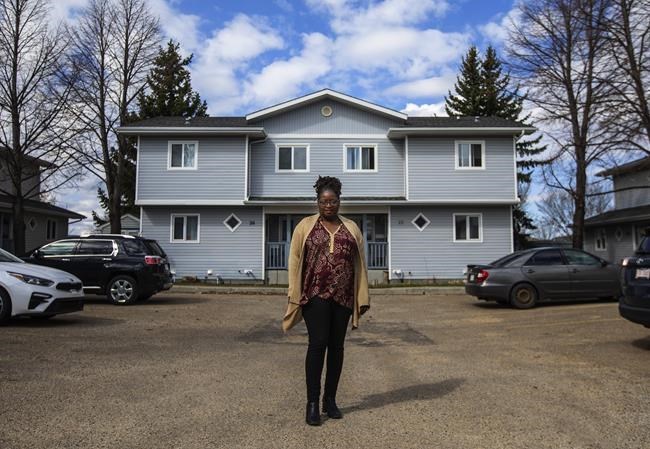Ayanna Inniss believes the co-op movement could be part of the solution to this country's housing affordability crisis.
The Edmonton-area woman still remembers the "soul destroying" experience of looking for affordable housing 20 years ago, before she moved into the Brittany Lane Housing Co-op in the bedroom community of Sherwood Park, Alta.
Newly separated at the time and cash-strapped, Inniss said she visited one run-down apartment building after another looking for a place she and her two little boys could call home.
“I can remember lots of concrete, no grass, no trees. I can remember windows with garbage bags covering them, and feeling like ‘this shouldn’t be what I have to accept, just because it’s what I can afford.”
Inniss considers it a stroke of luck that she found Brittany Lane and secured a well-kept three-bedroom unit in a complex that also offers residents access to community gardens, playgrounds, multi-sport courts and a community hall.
Today she pays $1,230 a month compared to what she says is a current market rate of about $1,600 for a similar unit.
"The fact that you need affordable housing shouldn't be synonymous with low quality housing," Inniss said.
Close to a quarter of a million people live in housing co-ops in Canada, a term used to describe mixed-income, multi-unit housing developments that are jointly owned by residents and operated on a non-profit basis.
That means that there is no outside landlord, and the co-op is controlled by members who have a vote in decisions.
Members own shares in the co-op, similar to owning shares in a corporation. When they move out of the co-op, the shares are passed to the next resident who moves into the unit.
The monthly "rent" the members pay goes toward paying down the building's mortgage, maintenance fees, and other operating costs.
Because the residents own the development and aren't seeking to make a profit, housing is provided at cost. Co-ops tend to be much more affordable than units available on the mainstream rental market, and that affordability gap has only deepened over time, as housing across the country has become more expensive.
Tim Ross, executive director of the Co-operative Housing Association of Canada, said recent research conducted by his organization shows the monthly rent for a two-bedroom co-op in Toronto in 2021 was almost 30 per cent cheaper than a two-bedroom unit on the private market. That's compared to 2006 data, which shows co-op units in that city were 16 per cent cheaper than market rates. (Some low-income tenants receive government subsidies to live in co-ops, so their rents can be even lower).
Because co-op housing developments are never resold, co-ops offer security of tenure, removing the risk that a renter will be evicted by a landlord seeking to sell the property or convert units into condos.
These factors, combined with the sense of community that goes along with living in a co-op, means that many co-op developments have very low vacancy rates and turnover, Ross said.
"Unfortunately, because the housing market isn’t responding to the needs of people in Canada, moving into a housing co-op is pretty much like winning the lottery," he said. "For that reason we see very long wait lists. Some wait lists are as long as five to 10 years.”
Most of the housing co-ops that exist today in Canada were built in the 1970s and 1980s, with federal, provincial and in some cases, municipal financing and funding.
However, the government debt crisis of the 1990s and the rise of neoliberalism has meant less political appetite to invest in housing in recent years, said Margaret Kohn, chair of the department of political science at the University of Toronto.
"It's not that it didn't work, it's that they (governments) decided they didn't want to spend on it," Kohn said.
But that could be beginning to change. The most recent federal budget targeted $9.5 billion over five years to net new housing initiatives to combat the growing crisis of affordability in Canada. Among those initiatives is a plan to invest $1.5 billion to build new co-op housing units in Canada, the largest federal investment in co-op housing in 30 years.
Kohn said the announcement is a good start, but that governments must continue investing to scale up the co-operative housing model across the country and provide a comprehensive solution the country's housing affordability crisis.
He said in the European Union, about 10 per cent of the overall housing stock is owned and managed by housing co-operatives — proof that the model could play a much greater role here in Canada
“I think this is the moment. The cost of market housing has increased so dramatically so quickly, and it’s placed a burden on lots of different kinds of people now," Kohn said. "I think there’s really some desperation right now, and that can really create a political movement. Hopefully it brings people together to think about alternatives.”
For her part, Inniss said securing a unit in a co-op housing development 20 years ago changed her and her children's lives.
“Because of the money I've saved, I had the ability to be able to afford softball lessons for my boys, and soccer lessons and piano lessons," Inniss said. "So (co-op housing) is something that has ripple effects into the next generation."
This report by The Canadian Press was first published May 12, 2022.
Amanda Stephenson, The Canadian Press



